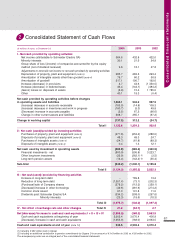APC 2004 Annual Report Download - page 58
Download and view the complete annual report
Please find page 58 of the 2004 APC annual report below. You can navigate through the pages in the report by either clicking on the pages listed below, or by using the keyword search tool below to find specific information within the annual report.
56
Suppliers
We have redefined our supplier quality strategy to
address sustainable development issues and
enhance our commitment to our host communities.
More generally, we encourage our suppliers to join the
Global Compact and give preference to those who
have deployed sustainable development programs
and initiatives. To date, 140 suppliers have signed the
Global Compact.
A specific questionnaire on sustainable development
has been included in our supplier certification pro-
cess. In addition, article 20 of our terms of purchase
calls for compliance with the OECD's Guidelines for
Multinational Enterprises and the International Labor
Organization's regulations.
In 2004, the Company implemented a sustainable
development agreement for suppliers in all its host
countries that sets specific commitments for both par-
ties.
74 %80 %
84 %84.5 %
2002 2003Dec. 31,
2004
2004
target
NEW2004 objective:
Ensure that 80% of our sites
have a long-term commitment with
the Schneider Electric Foundation.
Luli is now part of our corporate culture
Involvement in Southeast Asia
One of the largest natural disasters in history struck
Asia in December 2004. The entire Schneider
Electric community participated in the international
response, in particular by donating emergency aid
in Indonesia, Sri Lanka, India and Thailand; sup-
porting reconstruction projects selected by team
members in the countries hit by the tsunami; and
donating equipment and services to restore drinking
water and electric power in the disaster area.
Schneider Electric has a significant presence in the
countries affected by the tsunami. More than 4,000
people work for the Company in the region. From
the first day, they were actively involved in providing
assistance and support.
Customers
For Schneider Electric, sustainable development rep-
resents a strategic opportunity and a lever for growth.
We are marshalling all our resources to provide cus-
tomers with technological solutions that improve ener-
gy efficiency.
In 2004, we pursued our growth strategy in the
promising building automation and security market by
acquiring US-based Andover Controls. Following on
the 2003 acquisition of TAC, this move has extended
our lineup of solutions that allow customers to man-
age, optimize and reduce energy consumption.
Our TAC subsidiary has a performance contract with
the city of Nyköping in Sweden to reduce the munici-
pal energy bill by 17%. The solution offered will also
cut CO2 emissions by around 4,300 metric tons a
year.
We also organized a debate on sustainable develop-
ment in 2004 with representatives from major cus-
tomers like Véolia Environnement and France
Telecom and non-governmental organizations. The
event was broadcast live in 30 Schneider Electric
sales agencies in France and watched by 1,500
employees and customers.
Environmental performance
Schneider Electric is involved in a process to continu-
ously improve the environmental performance of its
facilities and products. In 1992, we published a formal
environmental policy. This policy was recently rede-
fined to take account of changes both inside and out-
side the Company. It is designed to improve manufac-
turing processes, promote eco-design and integrate
customer concerns in the area of environmental pro-
tection.
Facilities
We neither generate nor distribute electricity. Our
business primarily relies on assembly and control
techniques that are far removed from primary manu-
facturing. As a result, our atmospheric emissions are
not significant and below regulatory thresholds.
In 2004, we conducted our annual review of pollution
risks at all our manufacturing sites. None of our 197
production facilities is classified Seveso. We continu-
ously track 14 facilities, of which 7 in France, often
because of their past manufacturing history (in
France, this corresponds to sites that require special
environmental protection authorizations). Lastly spe-
cific action plans have been established to reduce
risks at 14 facilities. The plans have been completed
at ten sites and are still under way at the four others.
Provisions for environmental risks totaled 36 million
at December 31, 2004.
























